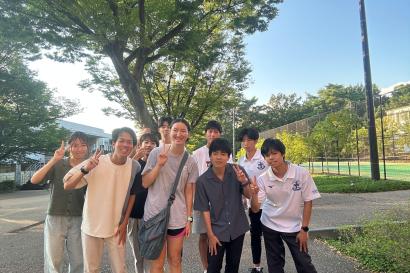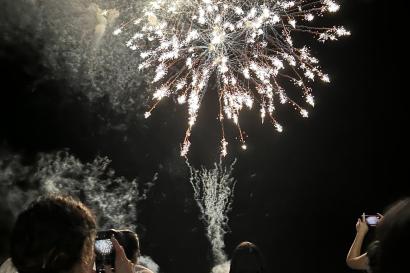My study abroad semester in Japan was fantastic, and it was made so amazing mostly due to the Japanese people. Japanese people are some of the nicest, funniest, and humblest people I know, and spending time with them—or simply noticing the differences between them and Americans in public settings—was one of my favorite takeaways from studying abroad.
Things
This may sound weird, but Japanese people love...things. Trinkets, knickknacks, novelties, the like—they love anything that hangs, sticks, or dangles. From entire shops dedicated to blinging out your phone, to the countless keychains, photocards, and stickers, there are so many opportunities to spend a few hundred yen customizing your phone, wallet, purse, anything, really. My Japanese friends oftentimes had keychains hanging from their phones or wallets, and I would notice that, in every tourist spot, a Japanese girl would be holding up a mini plushie or figure of her favorite idol or anime character in front of the site and take a picture of the item.
Everywhere I went, there would be gacha machines where you can get your knickknacks that way, and most of the time, I'd just ask in my head, "What would I use this for?" But eventually, I came to appreciate it. Unfortunately, I didn't buy anything as they're kind of a sensory nightmare, and I would be made fun of for it mercilessly back in America, but I enjoyed seeing all the little ways you can add your own flair to your things. However, it is a lot of plastic waste, and it really opened my eyes to how extremely consumeristic Japanese society is.
Standing In Lines
Whether it's for caramel apples, a pop-up shop, or to take a picture in front of a tourist site, Japanese people love to stand in lines. Well, I'm sure nobody likes it, but everywhere I went, I'd encounter a line for anything and everything. And the lines are long. I once saw an almost 40-person line for caramel apples in a pop-up shop in a mall in Osaka and was flabbergasted. The worst was when my friends convinced me to stand in a line to take a picture in front of the Itsukushima Jinja, and it took over an hour. The entire time, I noticed how we were the only foreigners in the line and how all the foreigners would bypass the line, go all the way to the front, take their picture a little to the left, and then leave to explore more of the island.
The cultural difference only solidified itself more when I returned to America and stood in a long line at Walmart, and the woman in front of me and the woman behind me both complained about the slowness out loud (we sympathized with the cashier about how Walmart didn't have more people on shift, of course—no bashing service workers here). But the fact that Americans hate standing in lines so much they complain and actively avoid them, and comparing that to Japanese people who stand in line for over an hour to get into a Hello Kitty pop-up shop, was a fascinating cultural difference I never thought would be different. If this tells you anything: be prepared to wait in lines.
Clapping In Unison
Any performance I went to, whether it was a musical (thanks to IES Abroad, I went to Cats), a street performance, or a taiko performance by Kodo (also thanks to IES Abroad), there was clapping in unison involved. Now, while you may say, "I'm sure most cultures clap in unison," in Japan it's every time, regardless of what's going on. For example, I saw a street performer in Osu who was doing extremely dangerous stunts, such as balancing on a board that was on a roller that was on a chair. It was insane. Anyway, in America, the crowd would gasp and scream and whoop and holler and most likely chant in unison, if that. However, the crowd stayed silent and clapped in unison instead to support him, which I thought was so interesting. I suppose it's a more respectful and less distracting way to show support to a performer or performance, which I think is neat. However, I couldn't help but gasp.
Being Quiet (At Anything And Everything)
Speaking of not gasping, I let out a short and strained scream when the extreme performer brought out a flamethrower, which I thought was an appropriate reaction, but clearly not as more people started staring at me instead of the performer. Alright then, don't make a noise when a man is juggling a chainsaw in front of me, got it. I learned my lesson again when we went to Cats, and some of the most unbelievable acts would happen in front of my eyes, and I had to force myself to be quiet because there was not a peep out of the audience, who was entirely Japanese. There were genuinely scary scenes that had jumpscares that almost made me gasp, but I had to suppress it because I heard nothing out of anybody else. Even at the end, nobody was hollering or whooping, just clapping. Again, I assume this has to do with being polite and to allow the performer to focus, but being my noisy American and Brazilian self (double the trouble), it was extremely difficult, so keep this in mind if you're a naturally reactive or loud person.
Hot Dogs
As an American, hot dogs are the central of American culture. At least, that's what I thought. There's nothing more American than eating a hot dog, except when I got to Japan, I realized we don't even eat hot dogs like that. Japanese people love hot dogs. Whether it's a stay-at-home mom putting mini hot dogs shaped like sausages in their kids bento, or eating a non-refrigerated hot dog sandwich straight off the shelf from Lawson's, or every other day for breakfast like at my host family's, you will be consuming your weight in hot dogs. But they aren't the huge, beefy hot dogs you're used to (if you're American). These are tiny and skinny, barely bigger than my pinky, and do not taste like American hot dogs at all. Americans, on the other hand, only really eat hot dogs on the Fourth of July and at sporting events. Many don't even eat them as they're convinced they're made up of ground-up pig feet and cow ears. I certainly don't like Japanese hot dogs, either. I don't think I can look at another hot dog for the rest of my life, to be honest.
This one is a little contradictory because Japanese people love Instagram and pretty much only communicate on there (at least with international students, I'm pretty sure they use Line with other Japanese people), but most of their Instagrams contain five pictures or fewer, and none of the pictures contain their faces. It's always pictures of random things, of concerts, of food, or of them—but they're covering their faces. Every Japanese person I spoke to would ask me for my Instagram within five minutes of the conversation, but none of them had more than a thousand followers, which perplexed me. If you're asking everybody for their Instagram, wouldn't you have more followers? Regardless, I very quickly learned that there was a QR code to easily share Instagram profiles, where it was, and how to pull it up immediately after being asked. That's how I made so many of my Japanese friends, and I'm so glad I was able to do that! A little hack: if you want to be friends with a Japanese person, ask for their Insta!
Once you arrive in Japan, keep a look-out for these unique cultural differences!

Isabella Madruga
I am a senior at Johns Hopkins University studying Writing Seminars (a fancy way of saying creative writing) and Sociology. My main goal in life is to be an author, so when I'm not scrolling on TikTok, I'm writing stories, reading, and daydreaming.






